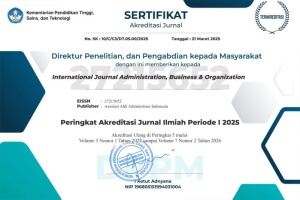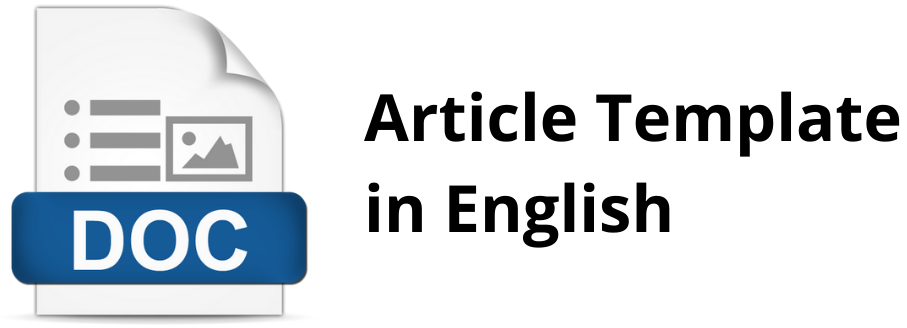The Effect of Ease of Use of The Shoppe Application Consumer’s Repurchase Interest: Student Perspective
Abstract
At the time of Covid-19 pandemic, e-commerce was the best choice for consumers to purchase their needs. E-commerce most frequented in Indonesia was Shopee. This study aims to determine the effect of the ease of use of the shopee application on the repurchase interest of shopee e-commerce consumers during the Covid-19 pandemic (a case study of Bandung State Polytechnic students). This research is a quantitative study using associative methods. The sampling method in this study is the method nonprobability sampling with snowball sampling technique. In this study, the sample size was 138 respondents. Data processing use software SPSS (statistical program for social science) for windows. The test results show that the ease of using the Shopee application has an effect on consumer repurchase interest.
References
Agustiani, C. (2014). Pengaruh kepuasan pelanggan terhadap minat beli ulang (studi kasus pada maskapai penerbangan lion air dijakarta). Jurnal Ekonomi, Manajemen dan Akuntansi. 9(3), 39-62.
Aladwani. (2002). The development of two tools for measuring the easiness and Usefulness of transactional web sites. European Journal of Information Systems. 11, 223-234.
Bao, J. (2015). The Impacts Of E-Service Quality On Customers’ Repurchase Intention In Platform Online Retailing: An Empirical Investigation. Fourteenth Wuhan International Conference On E-Business, 298–306.
Belanger, France et al. (2002). Trustworthiness in Electronic Commerce: The Role of Privacy, Security, and Site Attributes. Journal of Strategic InformationSystems 11.
Chaniago, Harmon. (2021). Manajemen Ritel & Implementasinya. Bandung: Edukasi Riset Digital
Chaniago, Harmon. (2020). Analisis Kualitas Pelayanan, Kualitas Produk, dan Harga pada Loyalitas Konsumen Nano Store. International Journal Administration, Business and Organization, 2020, Vol. 1 (2), 2020:59-69
Dwivedi, A., Johnson, L. W., & McDonald, R. E. (2015). Celebrity Endorsement,self-brand connection and Consumer-based brand equity. Journal of Product &Brand Management, 24(5), 449-61.https://doi.org/10.1108%2Fjpbm-10-2014-0722
Faircloth, J.B. (2005). Factors influencing nonprofit resource provider support decision:applying the brand equity concept to nonprofit. Journal of Marketing Practice and Theory, 13(3), 1-15. https://doi.org/10.1080%2F10696679.2005.11658546
Farhani, Iklima., Chaniago, Harmon. (2021). Faktor Penentu Transformasi Digital UMKM: Bukti dari Indonesia. Prosiding The 12th IRWN, Polban.
Ferdinand, A. (2014). Metode penelitian manajemen (5th ed.). Semarang: Badan Penerbit Universitas Diponogoro.
Gera, R. (2013). Evaluating The Relationship Of Online Service Quality Dimensions With Satisfaction, Value And Behavioral Outcome. African Journal Of Business Management, 7(10), 754–761. doi.org/10.5897/AJBM11.675
Gursida, Hari & Harmon. (2017). Metode Penelitian Bisnis dan Keuangan. Konsep dan Implementasinya. Bogor: Paspi
Harris, L. C., and M. M. H. Goode. (2010). Online Servicescape, Trust, and Purchase Intentions. Journal of Service Marketing, Vol. 24, No. 3: hal. 230-243
Hartono, J.M. (2008). Sistem informasi keperilakuan. Edisi Revisi. Yogyakarta: C.V Andi Offset
Hellier, P. K., Geursen, G. M., Carr, R. A., & Rickard, J. A. (2003).Customer repurchase intention. European Journal of Marketing,37(11/12), 1762-1800.
Inas Rafidah. (2017). Analisis Keamanan Kemudahan Dan Kepercayaan Terhadap Keputusan Pembelian Secara Online Di Lazada. Sekolah Tinggi Ilmu Ekonomi Indonesia (STIESIA) Surabaya. Jurnal Ilmu Dan Riset Manajemen.6(2).
Josang, Audun. (2007). Trust and Reputation system. Foundations of Security Analysis and Design IV. (Online), Australia.
Laudon, Kenneth C. & Laudon, Jane P. (1998). Management Information Systems - New Approaches to Organization & Technology. 5th edition, New Jersey: Prentice Hall
Lee, Hsiang. M., Lee, Ching. C., & Wu, C. C. (2011). Brand Image strategy affects brand equity after M&A. European Journal of Marketing, 45(7-8), 1091-1111.https://doi.org/10.1108%2F03090561111137624
Lu, J. (2001). Measuring cost/benefits of e-business applications and customer satisfaction. Proceedings of the 2nd International Web Conference, 29–30 November, Perth, Australia, 139-47
Muharam, Hari., Chaniago, Harmon., Endraria, Endraria., Harun, Amran Bin.. (2021). E-Service Quality, Customer Trust & Satisfaction: Market Place Consumer Loyalty Analysis. Jurnal Minds: Manajemen Ide dan Inspirasi. Vol. 8, No.2 (December) 2021: 237-254.
Munandar, Aris dan Efawati, Yen. (2020). Identification on Brand Loyalty (Study on Honda motorcycle namely Mega Pro). International Journal Administration, Business & Organization, Vol 1 (1), 26.
Nasution, Fahmi Natigor. (2004). Penggunaan Teknologi Informasi Berdasarkan Aspek Perilaku (Behavioral Aspect). Diakses dari http://library.USU.ac.id/download/fe/akunta nsi-fahmi2.pdf
Pearson,Mc Leoad, dan Schell, George. (2008).E-Commerece:Business, Techkology, and Society.4th Edition.NewJersye:PrenticeHall, Inc,
Razak, N. S., Ahmad, A. H., & Marimuthu, M. (2016). The Effect Of Website Quality On Repurchase Intention In Travel Agency’s Website In Malaysia. Asia Pacific Institute Of Advanced Research (Apiar), Valume 2.
Rowley, J. (2006) An analysis of the e-service literature: towards a research agenda. Internet Research, 16 (3), 339-359
Sanchez-Franco, M., Ramos, A., & Velicia, F. (2009). The moderating effect of gender on relationship quality and loyalty toward Internet service providers. Information & Management, 46(3), 196–202.
Sanusi. (2011).Metodologi Penenlitian Bisnis.Jakarta: Salemba Empat.
Sugiyono. (2008). Metode Penelitian Kuantitatif Kualitatif dan R&D. Bandung : ALFABETA
Sujarweni, Wiratna. (2014). Metodologi penelitian: Lengkap, praktis, dan mudah dipahami. Yogyakarta: PT Pustaka Baru
Tomlinson, E. C., Lewicki, R. J., & Dineen, B. R. (2002). Dealing with damaged trust: How to rebuild trust and temper distrust. Paper presented at the annual meeting of the Academy of Management, Denver.
Trisnawati, Ella. Suroso, Agus. Dan Kumorohadi, Untung. (2012). Analisis faktor-faktor kunci dari niat pembelian kembali secara online (studi kasus pada konsumen fesh shop). Jurnal Bisnis dan Ekonomi. Vol.19 No. 2 September
Wen Fan,Yi.Wu., Cheng-Chieh & Wu., Wei-Ting. (2010). The impacts of online retailing service recovery and perceived justice on consumer Loyalty. International Journal of Electronic Bussines Management.
Zeithaml, Valarie A., Parasuraman, A., & Malhotra, Arvind. (2002). Service quality delivery through web sites: A critical review of extant knowledge. Journal of the Academy of Marketing Science, 30(Fall), 362–410.
Zhang, Y., Fang, Y., Wei, K., Ramsey, E., McCole, P., & Chen, H. (2011). Repurchase intention in B2C e-commerce-A relationship quality perspective. Information & Management, 48(6), 192–200.
Copyright (c) 2021 Turfa Najmi Sadiki, Ivo Agesti Dwiyanti

This work is licensed under a Creative Commons Attribution 4.0 International License.
Authors who publish in this journal agree to the following terms:
- The authors confirm that they are the authors of the submitted article, which will be published (online) in the journal IJABO (International Journal Administration, Business & Organization) by the Asosiasi Ahli Administrasi Indonesia (A3i), Bandung, Indonesia. The author’s name will be evident in the article. The publisher makes all decisions regarding the layout and distribution of the work.
- Authors guarantee that the work is their own original creation and does not infringe any statutory or common-law copyright or any proprietary right of any third party. In case of claims by third parties, authors commit themself to defend the interests of the publisher and shall cover any potential costs.
- Authors retain copyright and grant the journal the right of first publication, with the work simultaneously licensed under a Creative Commons Attribution-ShareAlike 4.0 International License (CC BY-SA 4.0). This license allows the redistribution and reuse of papers provided the authorship is properly credited.
- Authors can enter into separate, additional contractual arrangements for the non-exclusive distribution of the journal's published version of the work (e.g., posting it to an institutional repository or publishing it in a book), with an acknowledgment of its initial publication in this journal.
- Authors are permitted and encouraged to post their work online (e.g., in institutional repositories or on their website) prior to and during the submission process, as this can lead to productive exchanges and earlier and greater citations of published work.

















